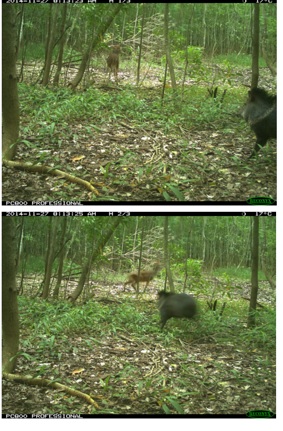Abstract
Sympatric species, having similar requirements, tend to compete for resources, especially in places where these are limited. Through monitoring with camera traps in waterholes in the Calakmul Region, two competition events were recorded due to interference between the collared peccary (Pecari tajacu) and the white-tailed deer (Odocoileus virginianus), confirming this antagonistic behavior as a strategy to access a shared and limited resource in this zone.
References
Gallina S. 1993. White-tailed deer and cattle diets at La Michilia Durango, México, Journal. of Range Management, 46(6), 487-492. https://doi.org/10.2307/4002857
García-Gil G. 2003. Colonización humana reciente y formación del paisaje agrario en la Reserva de la Biosfera de Calakmul, Campeche, México (Ph.D. Dissertation). Universidad Nacional Autónoma de México, México, D. F.
Gaxiola A, Armesto JJ. 2012. Ecología y evolución de las interacciones bióticas. En Del Val E y Boege K (Eds.), Competencia (pp.15-42). Universidad Nacional Autónoma de México-Fondo de Cultura Económica. México, D.F.
Hardin G. 1960. The Competitive Exclusion Principle. Science, 131(3409), 1292–1297. http://www.jstor.org/stable/1705965
Mayer JJ, Brandt PN. 1992. Identify, distribution and natural history of the peccaries, Tayassuidae. Pp. 433-455, en: Mammalian Biology in South America (Mares, M. A. y H. H. Genoways, eds.). Special Publication Series 6, Pymanuting Laboratory of Ecology, University of Pittsburgh, Linesville.
Mardero S, Nickl E, Schmook B, Schneider L, Rogan J. 2012. Sequias en el sur de la península de Yucatán: análisis de la variabilidad anual y estacional de la precipitación. Investigaciones Geográficas, Boletín del instituto de Geografía, UNAM, México 78: 19–33. https://doi.org/10.14350/rig.32466
Masters R, Bidwell TG, Shaw M. 1995. Ecology and Management of deer in Oklahoma. F-9009. Oklahoma Cooperative Extension Service. Division of Agricultural Sciences and Natural Resources, Oklahoma State University, pp 1-9.
Michael ED. 1967. Behavioral interactions of deer and some other mammals. The Southwestern Naturalist, 156-162. https://doi.org/10.2307/3669269
Park T. 1962. Beetles, competition and populations. Intricate ecological phenomenon is brought into laboratory and studied as an experimental model. Science, 138(3548):1369-1375.
Polis G.A, Myers CA, Holt RD. 1989. The ecology and evolution of intraguild predation-potential competitors that eat each other. Annual Review of Ecology and Systematics, 20:297-330. https://doi.org/10.1146/annurev.es.20.110189.001501
Ramírez-Lozano RG. 2004. Nutrición del Venado Cola Blanca. Editorial UANL.
Ramírez-Ortiz LM. 2016. Abundancia relativa y patrones de actividad por venados en dos sitios de la Región de Calakmul. Tesis de Licenciatura de la Universidad Autónoma de Campeche.
Reyna-Hurtado R. et al. 2019. Tapir population patterns under the disappearance of free-standing water. Therya, vol. 10, no 3, p. 353. https://doi.org/10.12933/therya-19-902
Sanchez-Pinzón K, Reyna-Hurtado R, Naranjo EJ, Keuroghlian A. 2020. Peccaries and their relationship with water availability and their predators in Calakmul, México. Therya, 11(2), 213-220. https://doi.org/10.12933/therya-20-878
Sánchez-Rojas G, Gallina S.2000. Mule deer (Odocoileus hemionus) density in a landscape element of the Chihuahuan Desert, Mexico. Journal of Arid Environments, 44(3), 357-368. https://doi.org/10.1006/jare.1999.0605
Sowls LK. 1997. Javelinas and other peccaries: their biology, management, and use. The Texas A&M University Press. College Station, EE. U.
Ticer CLD, Ockenfels RA, Devos JC Jr, Morrell TE. 1998. Habitat Use and Activity Patterns of Urban-Dwelling Javelina. Urban Ecosystems 2, 141–151. https://doi.org/10.1023/A:1009581632050
Zaiglin RE, DeYoung CA. 1989. Supplemental feeding of free-ranging deer in south Texas. Texas Journal of Agriculture and Natural Resources, 3, 39-41. https://txjanr.agintexas.org/index.php/txjanr/article/view/296
Zúñiga-Morales JA, Sima-Pantí D. 2015. Estrategia de mitigación y adaptación al cambio climático en Calakmul: una historia de éxito. Boletín de la Comunidad de Aprendizaje de Áreas Naturales Protegidas, 1: 5-9

This work is licensed under a Creative Commons Attribution 4.0 International License.





